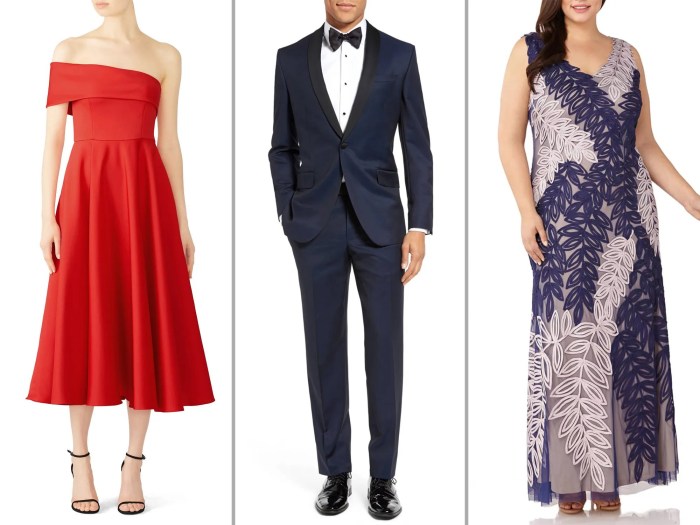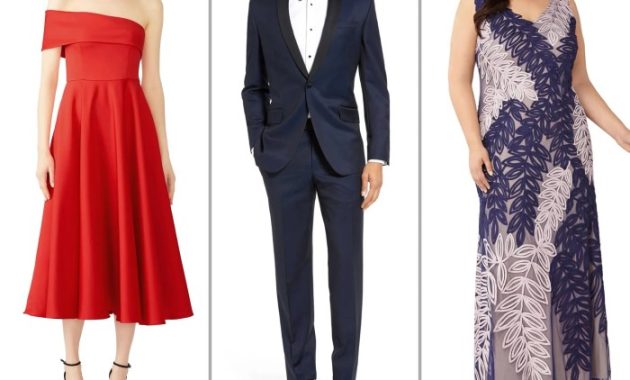Wedding Ceremony Dress Guide: Dress For Wedding Ceremony
Dress for wedding ceremony – Choosing the perfect outfit for a wedding ceremony can be a delightful yet challenging task. This guide provides a comprehensive overview of dress styles, etiquette, and styling tips to help you navigate the process and ensure you look and feel your best.
Types of Wedding Ceremony Dresses

Source: suitsupply.com
The type of dress you choose will depend on several factors, including the formality of the wedding, the venue, the time of day, and the overall theme. Here are some examples of dress styles suitable for various wedding ceremonies.
| Style | Description | Appropriateness | Example Fabrics |
|---|---|---|---|
| Formal Gown | Floor-length gown, often featuring intricate details like beading, lace, or embroidery. | Black-tie weddings, evening ceremonies | Silk, satin, velvet, lace |
| Cocktail Dress | Knee-length or midi-length dress, suitable for semi-formal occasions. | Semi-formal weddings, afternoon or evening ceremonies | Crepe, chiffon, silk blends |
| Midi Dress | Mid-calf length dress, offering a balance between formality and comfort. | Semi-formal to casual weddings, daytime or evening ceremonies | Cotton, linen, silk, jersey |
| Pantsuit | A stylish alternative to a dress, particularly suitable for less formal weddings. | Casual or semi-formal weddings, daytime ceremonies | Silk, crepe, linen |
Factors such as the venue (church, beach, garden), time of day (daytime, evening), and wedding theme (rustic, elegant, modern) significantly influence dress selection. A beach wedding calls for lighter fabrics and a less formal style compared to a black-tie event in a ballroom.
Silhouette Variations: Visualizing the different dress silhouettes helps in selecting a flattering style. An A-line dress is universally flattering, while an empire waistline accentuates the bust and is ideal for various body types. Mermaid silhouettes are best suited for those with a defined waist and hips, showcasing a curvy figure. Sheath dresses offer a sleek, streamlined look, while ball gowns create a dramatic and elegant appearance.
Dress Code Considerations, Dress for wedding ceremony
Understanding wedding dress codes is crucial for selecting appropriate attire. Different dress codes indicate varying levels of formality.
- Black-tie: Formal gowns, tuxedos. Guests should opt for elegant, floor-length gowns or sophisticated cocktail dresses.
- Semi-formal: Cocktail dresses, dressy pantsuits. Guests can choose knee-length or midi dresses or dressy separates.
- Casual: Sundresses, nice pants and a blouse. Guests should aim for comfortable yet presentable attire, avoiding overly casual clothing like jeans and t-shirts.
The wedding location also impacts attire. A church wedding might require more formal attire than a beach wedding, which allows for more relaxed and comfortable choices. Always prioritize the dress code specified by the couple.
Fabric and Color Choices for Wedding Ceremony Dresses

Source: theknot.com
Fabric and color choices should align with the season and formality of the wedding.
| Fabric | Season/Formality |
|---|---|
| Silk | Formal events, all seasons (lighter silks for warmer months) |
| Lace | Formal events, spring/autumn |
| Chiffon | Semi-formal events, spring/summer |
| Linen | Casual to semi-formal, spring/summer |
| Velvet | Formal events, autumn/winter |
Avoid wearing white or ivory, as these are traditionally reserved for the bride. Bright, bold colors are generally suitable for daytime events, while softer, richer tones are appropriate for evening ceremonies. Choose colors that complement your complexion and the overall wedding aesthetic.
Spring Wedding Colors: Pastel shades like blush pink, lavender, mint green, and light yellow. Autumn Wedding Colors: Burgundy, emerald green, navy blue, and burnt orange.
Accessories and Styling
Accessories play a vital role in completing your wedding guest look. The right accessories can elevate a simple dress or add a touch of personality to a more elaborate outfit.
- Jewelry: Delicate necklaces, earrings, and bracelets are suitable for most occasions. Avoid overly flashy or large pieces.
- Shoes: Choose shoes that are comfortable and appropriate for the venue and dress code. Heels are generally suitable for formal events, while flats or wedges are more appropriate for casual weddings.
- Handbags: A small clutch or shoulder bag is ideal for formal events, while a larger tote bag might be more suitable for casual weddings.
Styling depends on the dress and the overall look you wish to achieve. A simple dress can be dressed up with statement jewelry and heels, while a more elaborate dress might look best with minimal accessories.
Hair and makeup should complement your outfit and the formality of the event. A sleek updo might be suitable for a formal wedding, while loose waves might be more appropriate for a casual affair. Makeup should be elegant and enhance your natural features.
Finding the Perfect Dress
Finding the perfect wedding guest dress involves careful consideration of several factors.
- Set a Budget: Determine how much you’re willing to spend before you start shopping.
- Consider Your Body Type: Choose a style that flatters your figure.
- Reflect Your Personal Style: Select a dress that reflects your personality and sense of style.
Where to Shop:
Choosing the right attire for a wedding ceremony can be a fun yet challenging process. The dress code often dictates the appropriate level of formality, but sometimes you can find stylish options outside the norm. For instance, if you’re looking for something unique and elegant, consider exploring the options available in black and purple; you might find exactly what you’re looking for with a quick search on sites like black and purple dresses for wedding.
Ultimately, remember that your outfit should reflect your personal style while respecting the wedding’s overall atmosphere.
- Bridal boutiques
- Department stores
- Online retailers
- Specialty stores
Always try on dresses before making a final decision. Ensure the dress fits well and consider alterations if necessary. A properly fitted dress will look and feel its best.
Popular Questions
What if the invitation doesn’t specify a dress code?
If the invitation lacks a dress code, err on the side of semi-formal. A cocktail dress or a stylish pantsuit is usually a safe bet.
Can I wear a dress I’ve worn to other events?
Yes, but ensure the dress is clean, in good condition, and appropriate for the wedding’s formality. Avoid anything too casual or revealing.
What if I’m unsure about the appropriateness of a color?
When in doubt, opt for a neutral or pastel shade. Avoid white, ivory, and very bright colors that might overshadow the bride.
What about plus-size options for wedding guest attire?
Many retailers offer stylish and flattering plus-size options for wedding guest dresses. Look for dresses that accentuate your best features and are comfortable to wear.

